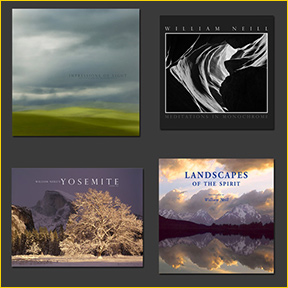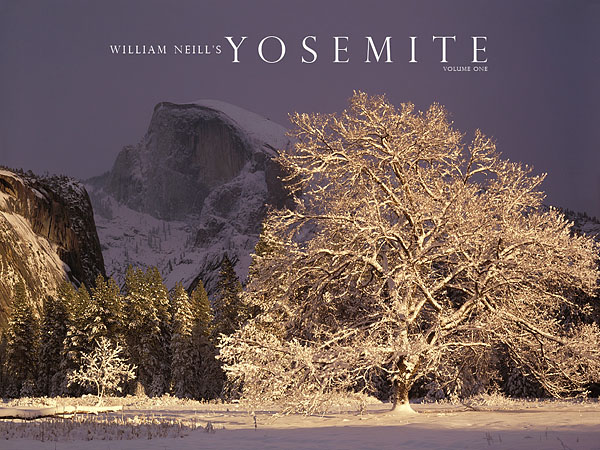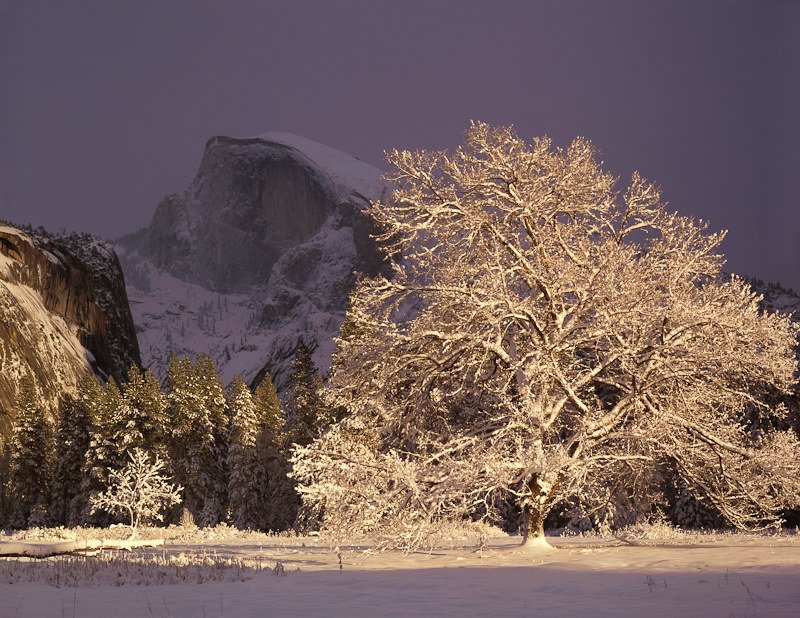
Half Dome and Elm tree, winter, Yosemite National Park, California 1990
If you ask me what my favorite light for photography is, I will say soft light like on a rainy day. I will say that the reason for this preference is the subtlety of light where harsh shadows are not present and for the richness of colors that can be recorded in such conditions. Sometimes though, nature’s lighting is anything but subtle. When the sun is shining, I look for the edges of light.
The most dramatic lighting conditions for outdoor photography often occur when light and shadow work together to define a subject. It is these grand theatrics in nature that give landscape photographers such a thrill. The contrast of a dark shadow behind a backlit branch of autumn leaves, or a sunset-lit mountain, glowing out from a dark storm cloud, will give power to your images. Shapes and lines stand apart with graphic emphasis. However, the use of such contrast cannot be indiscriminate. If forms are to be accentuated by the light, then one must be highly selective. Extra time spent searching for the best shapes or designs is always worthwhile.
The image represented here, “Half Dome and Elm, winter,” was photographed in 1990 on a January afternoon. I was driving into Yosemite Valley from my nearby home to check for mail at my Post Office box! I confess that my timing was also based on hopes for some good light as a big winter storm was clearing, and good fortune came my way. Warm afternoon light struck this elm tree as Half Dome, darkened by storm clouds, brooded in the background. I plowed through the snow in the meadow with my 4×5 camera looking for the right place to stand.
In these spectacular conditions, where an adequate photograph could have been taken blindly, I felt that corresponding adrenaline rush of opportunity! Still, I needed time to balance the elements of elm tree, meadow and cliffs. Fortunately, the light remained long enough for me to find my spot. The location I chose placed the tree fully in the frame but off to the right. With no zoom lens, I had to use my feet and still have a foreground clean of footprints. By including the entire tree, the wonderful shape of the elm is given prominence in this composition. With this angle, Half Dome was clearly visible but of secondary importance. The dark background of Half Dome and cliffs sets off the tree’s snow-laden branches. As with many clearing storms in Yosemite, by the time sunset arrived that day, the sky was clear and the dramatic edge of light was gone.
Sometimes, as with my Half Dome image, these edges of light are caused by weather. Other situations are more predictable as they are a function of season or time of day in combination with the local geography. I know meadows in Yosemite Valley where the oak trees become dramatically backlit as the morning sun rises over the cliffs. The cliffs, still in shadow, provide the dark backdrop. The graceful lines of the tree become silhouetted while the leaves are glowing in light. These more predictable conditions are found everywhere, which is why frequenting your local and favorite landscapes will give you the chance to learn its nuances.
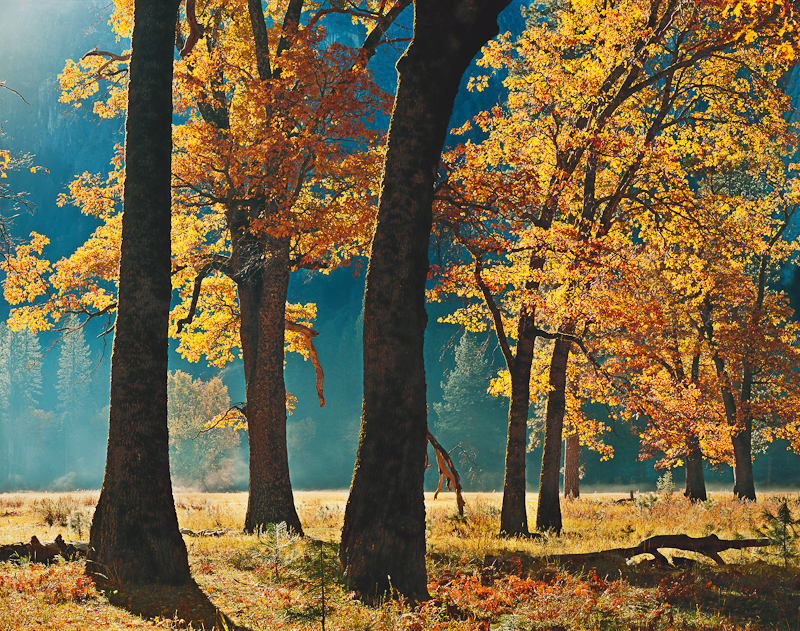
Black oaks, autumn, El Capitan Meadow, Yosemite Valley, Yosemite National Park, California 1984
Dawn and dusk are times of the day when light is on the edge between day and night. Even though the contrast of light and shadow is not directly seen, the light reflected at low angle through the earth’s atmosphere gives lovely colors and a glow on the landscape. This time of day, often during that half an hour before sunrise, and after sunset, is a magical and productive time to photograph.
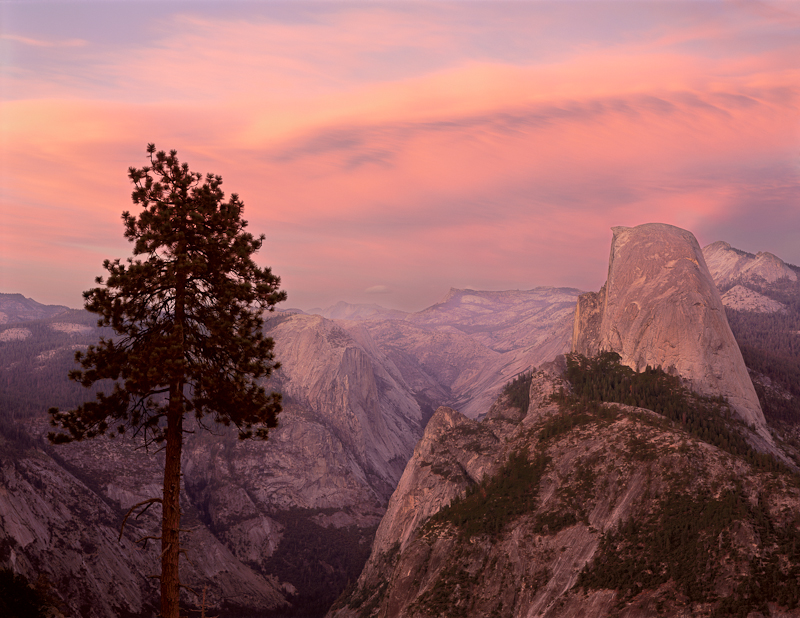
Half Dome and Tenaya Canyon at sunset from Washburn Point, Yosemite National Park, California 1996
Many photographers know about utilizing the edges of light, but it is worth repeating. Sometimes we all get stuck in rut, as I often do with my attraction to soft light. Take a look through your own favorite images to see what light your prefer but also be open all the magic light nature brings you. Be a student of light, both in the field and when editing where learning your own preferences will better prepare you for the next sessions. Speaking of edges, someday I would like to see the edge of light on our Earth from space! Have you explored the edges of light lately?
To see and learn about William Neill’s eBooks, click below:
William Neill e-Books Now Available for Download Here
In his Yosemite eBook, Neill has written commentary on the aesthetics and technical aspects of creating each photograph. This includes location information which will be helpful to photographers who visit the park. The PDF book shows each photograph in high resolution and offers interaction between each image and the Photo Notes section at the back of the book.
He conductsOne-on-One Workshops at his studio in Oakhurst, CA, which is only a few miles from Yosemite. You will find his other eBooks available for download: William Neill eBooks
Previous articles by William Neill on The Luminous Landscape
Landscapes of the Spirit
Impressions of Light
William Neill, a resident of the Yosemite National Park area since 1977, is a landscape photographer concerned with conveying the deep, spiritual beauty he sees and feels in Nature. Neill’s award-winning photography has been widely published in books, magazines, calendars, posters, and his limited edition prints have been collected and exhibited in museums and galleries nationally, including the Museum of Fine Art Boston, Santa Barbara Museum of Art, The Vernon Collection, The Polaroid Collection and The Ansel Adams Gallery. Neill received a BA degree in Environmental Conservation at the University of Colorado. In 1995, Neill received the Sierra Club’s Ansel Adams Award for conservation photography.
You May Also Enjoy...
Cottonwood Parking Site
Watchman of the Cove© Miles HeckerCLICK ABOVE IMAGE TO SEE GOOGLE MAP LOCATIONSEASONS The Coyote Buttes area is typical of the high southwestern desert. Summer
Teddy Bear Cholla
Smarter than the average bear© Miles HeckerCLICK ABOVE IMAGE TO SEE GOOGLE MAP LOCATION SEASONS Access to the Sonoran Desert section in the Rincon Mountain
